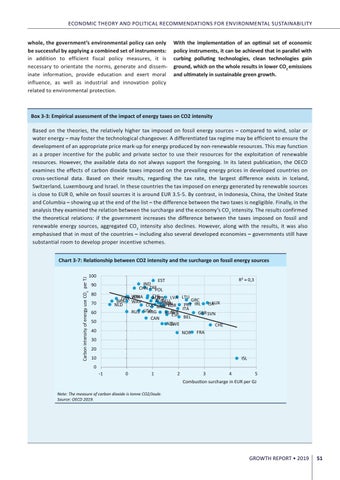ECONOMIC THEORY AND POLITICAL RECOMMENDATIONS FOR ENVIRONMENTAL SUSTAINABILITY whole, the government’s environmental policy can only be successful by applying a combined set of instruments: in addition to efficient fiscal policy measures, it is necessary to orientate the norms, generate and disseminate information, provide education and exert moral influence, as well as industrial and innovation policy related to environmental protection.
With the implementation of an optimal set of economic policy instruments, it can be achieved that in parallel with curbing polluting technologies, clean technologies gain ground, which on the whole results in lower CO2 emissions and ultimately in sustainable green growth.
Box 3-3: Empirical assessment of the impact of energy taxes on CO2 intensity Based on the theories, the relatively higher tax imposed on fossil energy sources – compared to wind, solar or water energy – may foster the technological changeover. A differentiated tax regime may be efficient to ensure the development of an appropriate price mark-up for energy produced by non-renewable resources. This may function as a proper incentive for the public and private sector to use their resources for the exploitation of renewable resources. However, the available data do not always support the foregoing. In its latest publication, the OECD examines the effects of carbon dioxide taxes imposed on the prevailing energy prices in developed countries on cross-sectional data. Based on their results, regarding the tax rate, the largest difference exists in Iceland, Switzerland, Luxembourg and Israel. In these countries the tax imposed on energy generated by renewable sources is close to EUR 0, while on fossil sources it is around EUR 3.5-5. By contrast, in Indonesia, China, the United State and Columbia – showing up at the end of the list – the difference between the two taxes is negligible. Finally, in the analysis they examined the relation between the surcharge and the economy’s CO2 intensity. The results confirmed the theoretical relations: if the government increases the difference between the taxes imposed on fossil and renewable energy sources, aggregated CO2 intensity also declines. However, along with the results, it was also emphasised that in most of the countries – including also several developed economies – governments still have substantial room to develop proper incentive schemes. Chart 3-7: Relationship between CO2 intensity and the surcharge on fossil energy sources Carbon intensity of energy use CO2 per TJ
100
EST IND ZAF CHN POL CHL WMA IDN AUS JPN LVA DNK AUT DEU BRA WAV TUR FIN CZE NLD COL MEX KOR USA RUS SVK ARG HUN ESP CAN NZL SWE
90
80 70 60
50 40
R² = 0,3
LTU
GRC PRT IRL ISRLUX ITA GBR SVN BEL CHE
NOR
FRA
30
20 10 0
ISL -1
0
1
2
3
4
5
Combus�on surcharge in EUR per GJ Note: The measure of carbon dioxide is tonne CO2/Joule. Source: OECD 2019.
GROWTH REPORT • 2019
51
